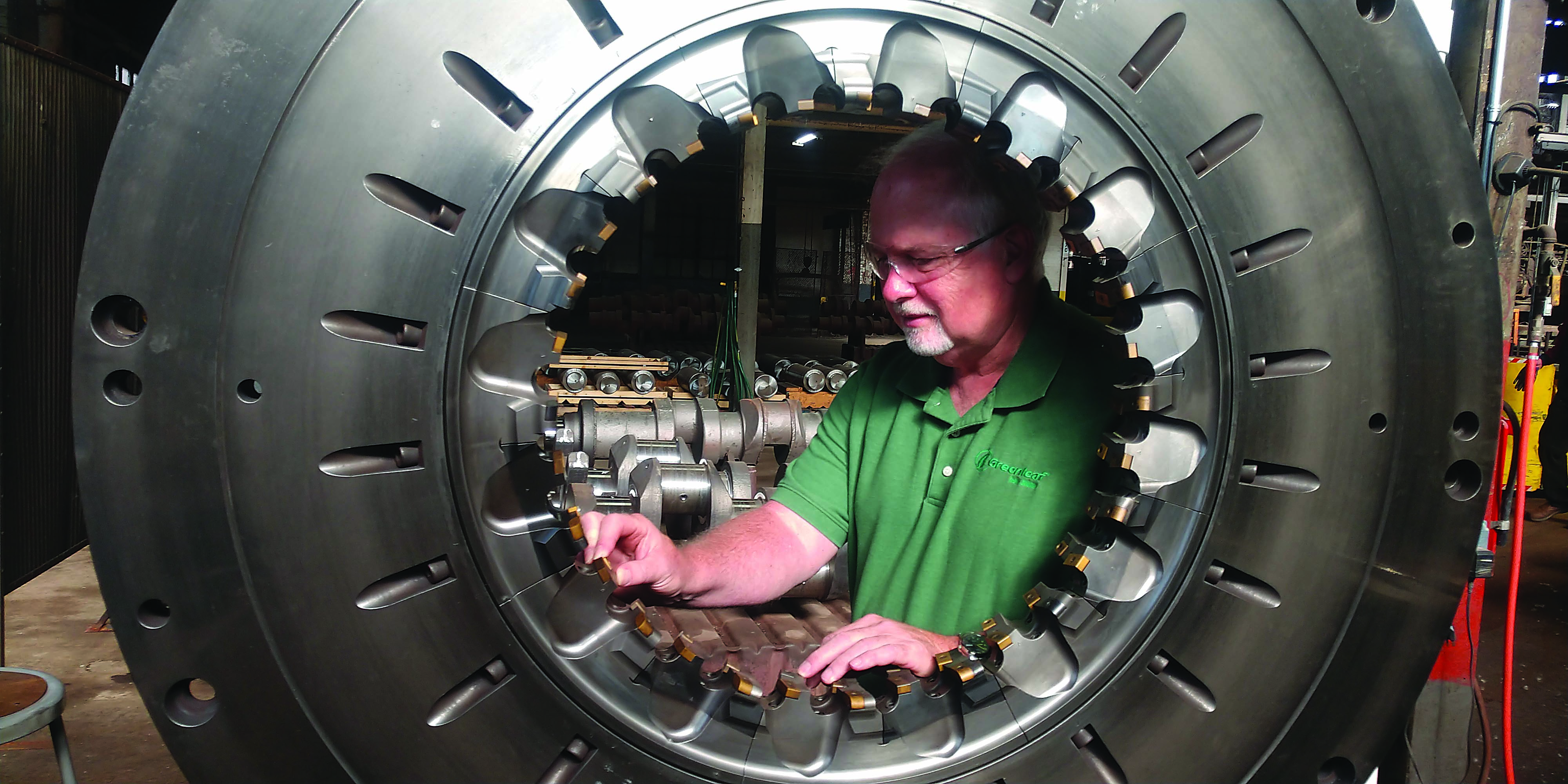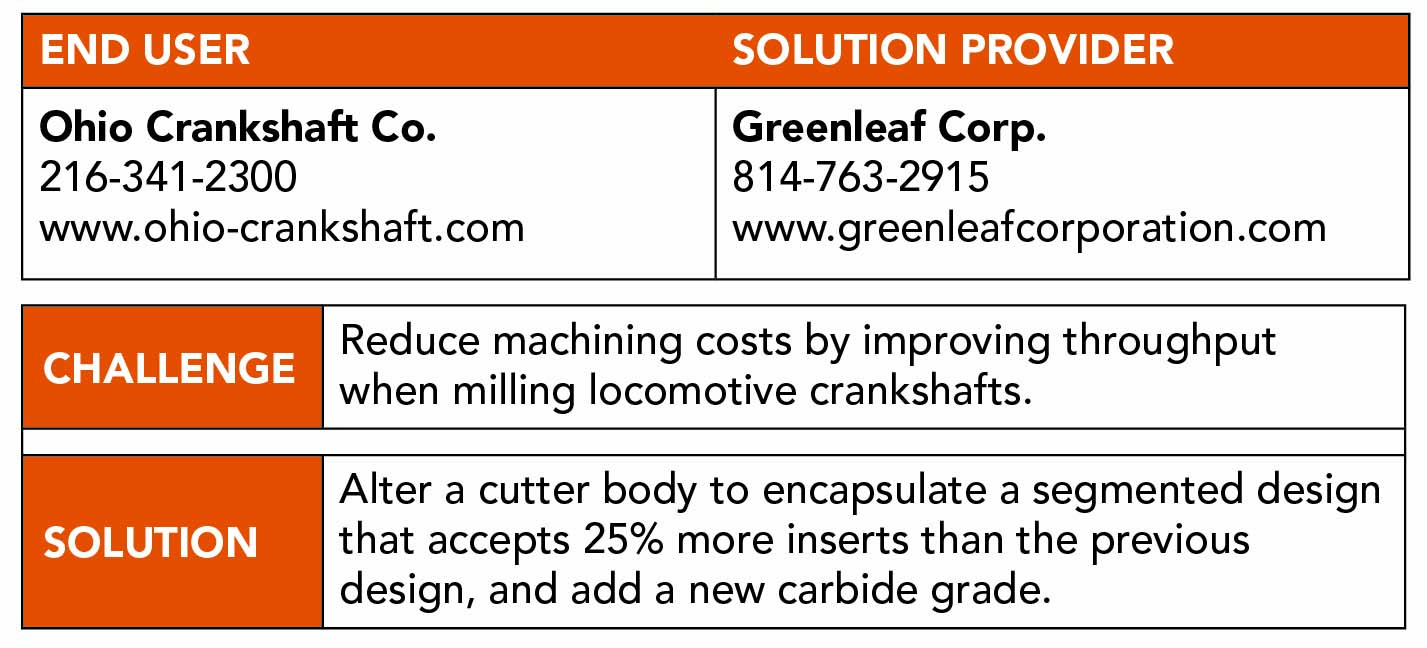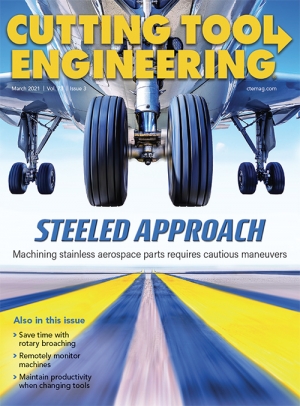Developing a partnership between a cutting tool manufacturer and a part manufacturer is one avenue to boost machining productivity. Greenleaf Corp. and Ohio Crankshaft Co. are long-standing companies that joined forces to significantly enhance throughput, said Bernie Kirwin, OCCO’s engineering manager, who started working on the shop floor in 1984. (Last year, Saegertown, Pennsylvania-based Greenleaf celebrated its 75th anniversary, and Cleveland-based OCCO, which produces large crankshafts, camshafts and other critical components for locomotive and marine diesel engines, pumps and other reciprocating equipment, turned 100.)
“We did a lot of testing of carbide back in the day,” he said. “We found that Greenleaf developed a good product, and we developed a good relationship with Greenleaf.”
As a result, OCCO talked to the toolmaker when OCCO’s team determined that there must be a more efficient way to mill locomotive crankshafts from 5046 steel forgings, which was taking about four hours or more to machine a shaft with up to two indexes of the carbide inserts. When the inserts need to be indexed, the cutter must be removed from OCCO’s crankshaft milling machine tool, and machining stops for about an hour.

Denny Carpenter, sales and service engineer at Greenleaf, inspects milling cutter inserts and segments. Image courtesy of Greenleaf
“We wanted to be able to use some existing cutter bodies and apply new technology to them,” said Denny Carpenter, sales and service engineer at Greenleaf.
The cutter bodies were altered to encapsulate a segmented design, which allowed more insert pockets, increasing the number of inserts by 25%. The design enables OCCO to change worn segments.
The redesign permitted the company to increase the feed rate about 25%, Kirwin said, noting that feeds range from 50.8 to 1,524 mm/min. (2 to 60 ipm).
“We try to maintain a 0.012" (0.305 mm) chip load,” he said.
Kirwin said the cutter rotates and oscillates about the x- and y-axes as it cuts while the workpiece
remains stationary, and coolant is not applied.
In addition to changing the design of the cutter body, OCCO switched to Greenleaf’s GA5036 carbide grade. Carpenter said the grade has a higher level of cobalt than the previous grade that was used, enhancing toughness to cut steel forgings at a fairly high speed and extending tool life, while the multilayer chemical vapor deposition coating of the grade effectively resists wear and heat.
He said the insert geometry also is well suited for the task at hand.
“We did some pretty extensive edge preps to determine what was needed for the carbide grade and for the application,” Carpenter said.

Kirwin said the cutter rotates and oscillates about the x- and y-axes as it cuts while the workpiece remains stationary, and coolant is not applied.
In addition to changing the design of the cutter body, OCCO switched to Greenleaf’s GA5036 carbide grade. Carpenter said the grade has a higher level of cobalt than the previous grade that was used, enhancing toughness to cut steel forgings at a fairly high speed and extending tool life, while the multilayer chemical vapor deposition coating of the grade effectively resists wear and heat.
He said the insert geometry also is well suited for the task at hand.
“We did some pretty extensive edge preps to determine what was needed for the carbide grade and for the application,” Carpenter said.
Furthermore, OCCO’s machine was upgraded mechanically to allow higher cutting speeds. Working with the machine builder, the company installed a variable-frequency drive to enable the cutter to be programmed conveniently to different spindle speeds.
“It’s just a matter of plugging in some numbers,” Kirwin said. “We are able to program that rpm so we can get a higher surface footage and increase our feed rates.”
He said the company saw its biggest improvement when milling a crankshaft for OCCO’s 16-cylinder 710 model, cutting the four-hour cycle time in half and eliminating the need to index the inserts until the part was completed. The company also manufactures crankshafts and camshafts for eight-, 12- and 20-cylinder locomotives.
In some cases, costs were reduced by a factor of four, but further gains are being targeted.
“We are continuously looking at how we can improve the design of the cutters, the segments,” Carpenter said. “In engineering, we have some initial work being done on the next generation.”
Contact Details
Related Glossary Terms
- chemical vapor deposition ( CVD)
chemical vapor deposition ( CVD)
High-temperature (1,000° C or higher), atmosphere-controlled process in which a chemical reaction is induced for the purpose of depositing a coating 2µm to 12µm thick on a tool’s surface. See coated tools; PVD, physical vapor deposition.
- coolant
coolant
Fluid that reduces temperature buildup at the tool/workpiece interface during machining. Normally takes the form of a liquid such as soluble or chemical mixtures (semisynthetic, synthetic) but can be pressurized air or other gas. Because of water’s ability to absorb great quantities of heat, it is widely used as a coolant and vehicle for various cutting compounds, with the water-to-compound ratio varying with the machining task. See cutting fluid; semisynthetic cutting fluid; soluble-oil cutting fluid; synthetic cutting fluid.
- feed
feed
Rate of change of position of the tool as a whole, relative to the workpiece while cutting.
- gang cutting ( milling)
gang cutting ( milling)
Machining with several cutters mounted on a single arbor, generally for simultaneous cutting.
- milling
milling
Machining operation in which metal or other material is removed by applying power to a rotating cutter. In vertical milling, the cutting tool is mounted vertically on the spindle. In horizontal milling, the cutting tool is mounted horizontally, either directly on the spindle or on an arbor. Horizontal milling is further broken down into conventional milling, where the cutter rotates opposite the direction of feed, or “up” into the workpiece; and climb milling, where the cutter rotates in the direction of feed, or “down” into the workpiece. Milling operations include plane or surface milling, endmilling, facemilling, angle milling, form milling and profiling.
- milling cutter
milling cutter
Loosely, any milling tool. Horizontal cutters take the form of plain milling cutters, plain spiral-tooth cutters, helical cutters, side-milling cutters, staggered-tooth side-milling cutters, facemilling cutters, angular cutters, double-angle cutters, convex and concave form-milling cutters, straddle-sprocket cutters, spur-gear cutters, corner-rounding cutters and slitting saws. Vertical cutters use shank-mounted cutting tools, including endmills, T-slot cutters, Woodruff keyseat cutters and dovetail cutters; these may also be used on horizontal mills. See milling.
- milling machine ( mill)
milling machine ( mill)
Runs endmills and arbor-mounted milling cutters. Features include a head with a spindle that drives the cutters; a column, knee and table that provide motion in the three Cartesian axes; and a base that supports the components and houses the cutting-fluid pump and reservoir. The work is mounted on the table and fed into the rotating cutter or endmill to accomplish the milling steps; vertical milling machines also feed endmills into the work by means of a spindle-mounted quill. Models range from small manual machines to big bed-type and duplex mills. All take one of three basic forms: vertical, horizontal or convertible horizontal/vertical. Vertical machines may be knee-type (the table is mounted on a knee that can be elevated) or bed-type (the table is securely supported and only moves horizontally). In general, horizontal machines are bigger and more powerful, while vertical machines are lighter but more versatile and easier to set up and operate.
- milling machine ( mill)2
milling machine ( mill)
Runs endmills and arbor-mounted milling cutters. Features include a head with a spindle that drives the cutters; a column, knee and table that provide motion in the three Cartesian axes; and a base that supports the components and houses the cutting-fluid pump and reservoir. The work is mounted on the table and fed into the rotating cutter or endmill to accomplish the milling steps; vertical milling machines also feed endmills into the work by means of a spindle-mounted quill. Models range from small manual machines to big bed-type and duplex mills. All take one of three basic forms: vertical, horizontal or convertible horizontal/vertical. Vertical machines may be knee-type (the table is mounted on a knee that can be elevated) or bed-type (the table is securely supported and only moves horizontally). In general, horizontal machines are bigger and more powerful, while vertical machines are lighter but more versatile and easier to set up and operate.
- sawing machine ( saw)
sawing machine ( saw)
Machine designed to use a serrated-tooth blade to cut metal or other material. Comes in a wide variety of styles but takes one of four basic forms: hacksaw (a simple, rugged machine that uses a reciprocating motion to part metal or other material); cold or circular saw (powers a circular blade that cuts structural materials); bandsaw (runs an endless band; the two basic types are cutoff and contour band machines, which cut intricate contours and shapes); and abrasive cutoff saw (similar in appearance to the cold saw, but uses an abrasive disc that rotates at high speeds rather than a blade with serrated teeth).



